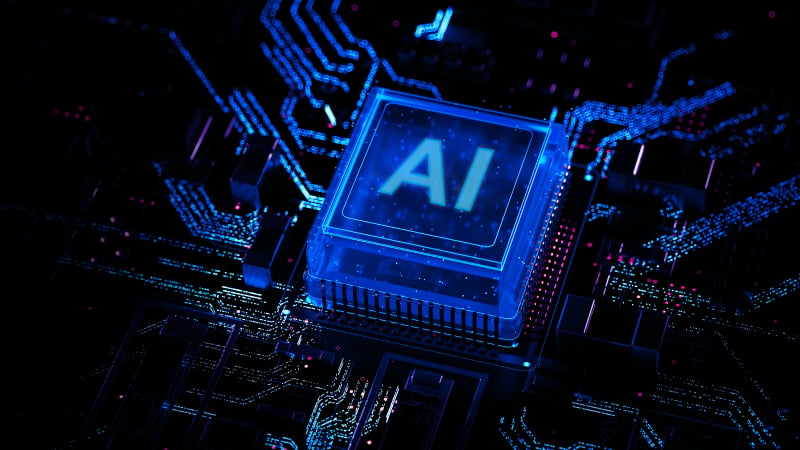The widespread use of artificial intelligence (AI) workloads and instances necessitates uninterruptible power supply (UPS) systems capable of managing step changes in graphics processing unit (GPU) load during operations without power supply disruptions. This technical note details how Vertiv’s large UPSs successfully maintain IEC 62024-3 Class 1 power stability under various conditions, serving as a performance reference for UPS deployments supporting AI clusters.
A performance test was conducted on the Vertiv™ Liebert® EXL S1, Vertiv's large UPS system that shares component architecture with the recently launched Vertiv™ Trinergy™. In the test, the Vertiv™ Liebert® EXL S1 is interfaced with power loads from high-performance computing applications in AI data centers. The primary objective was to evaluate the UPS system’s ability to maintain stable output voltage and current.
The test involved detailed monitoring and analysis of the UPS’s performance parameters, including input and output voltage, current, and frequency. Throughout multiple AI training cycles, specific focus was given to the UPS system's response to the AI workload's high compute and idle cycles.
Key performance metrics were assessed in three different scenarios:
- During operation on utility
- During the transition from utility to generator
- During operation on generator
AI training cycle in high-performance computing
The AI power load (running on NVIDIA H100 GPU) consists of 2 seconds of high computing load at 90% of the nominal large followed by 2 seconds of idle at 50% of the nominal UPS systems power in AI data centers.
AI power load profile zoom view:

AI power load profile macro view:

Scenario 1: Operation on utility
In this scenario, the performance of Liebert® EXL S1 in handling AI workloads while operating on utility power was evaluated. The analysis focused on input and output voltage, current, and frequency during multiple AI training cycles. The AI power load introduced rapid changes in current, creating significant fluctuations in the input signals. Despite these fluctuations, the UPS system effectively regulated the output, maintaining stable voltage and frequency. Detailed observations showed that the UPS handled the pulsing AI power load without significantly impacting the output parameters.
Instantaneous output voltage and current over several AI training cycle:
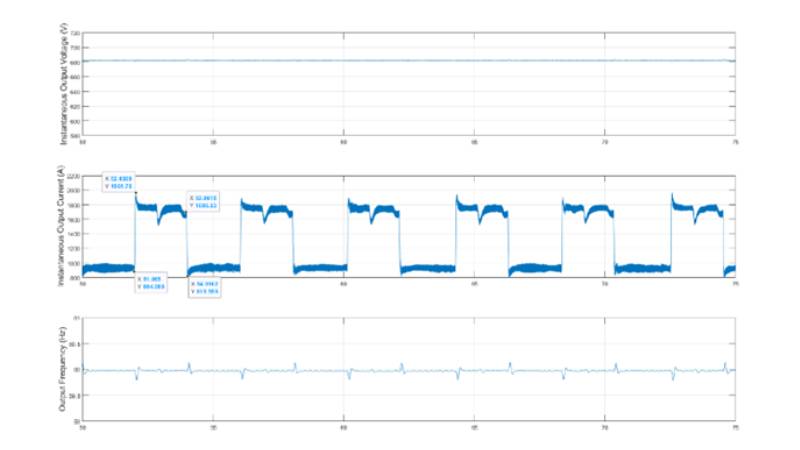
Battery usage analysis
The following shows the macro view of the battery voltage and UPS DC Link voltage (top trace), Phase A Input current (2nd trace), Phase A Output voltage (3rd trace), and Phase A Output current (4th trace). The battery current was not able to be measured since the battery was only used during the break-before-make transfer from the utility to the generator. Otherwise, the battery is never used as the load from high-performance computing applications pulses. The output voltage is maintained well within IEC Class 1.
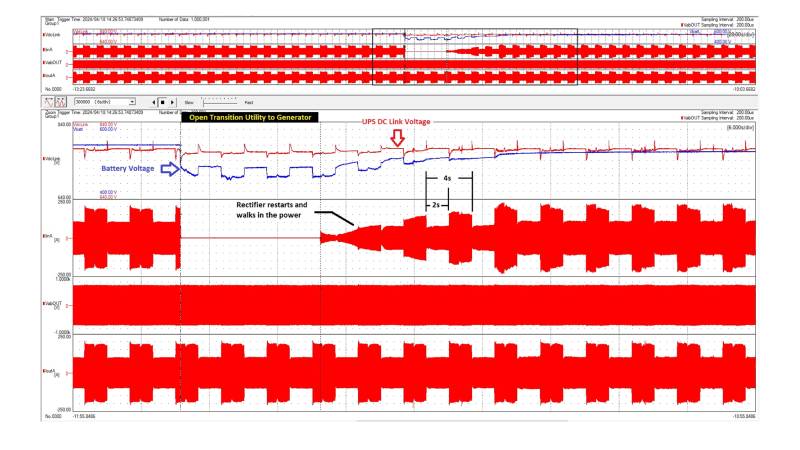
Scenario 2: Transition from utility to generator
In this scenario, the performance of Liebert® EXL S1 during a transition from utility power to generator power was analyzed. Key parameters such as input voltage, current, and frequency were recorded to observe the effects of the automatic transfer switch's break-before-make transition. The primary focus was to assess the UPS's capability to maintain stable output voltage, current, and frequency during this critical transition period. The AI power load's pulsing nature introduced fluctuations in the input signals. Despite this, the UPS system successfully maintained consistent output parameters, managing power source transitions without compromising the load's stability.
Output voltage, current, and frequency:
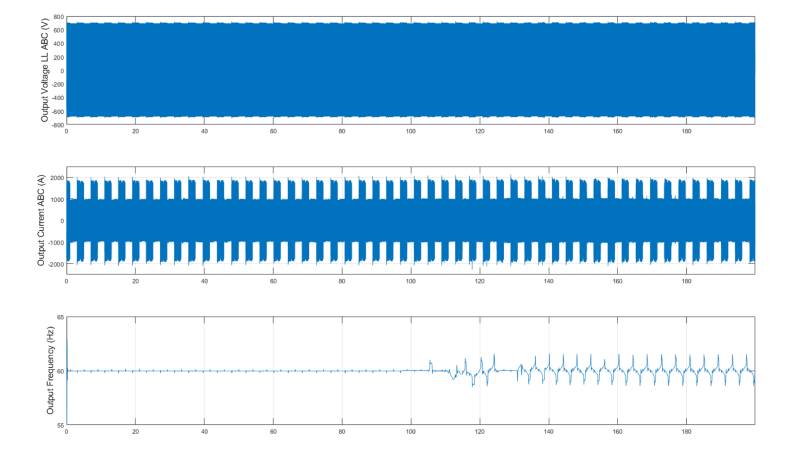
Input voltage, current, and frequency

Scenario 3: On generator
In this scenario, Liebert® EXL S1 was tested with AI power load while operating on generator power. The test included zoomed-in and extended views of the AI training cycles, focusing on input and output voltage, current, and frequency. The generator created fluctuations in voltage and frequency, but the UPS system effectively regulated the output, allowing a minimal variation in voltage and frequency supplied to the AI power load. Detailed observations revealed that the large UPS could handle rapid fluctuations and high slew rates in input current and maintain stability in output currents and voltages.
Zoom view of a training cycle:
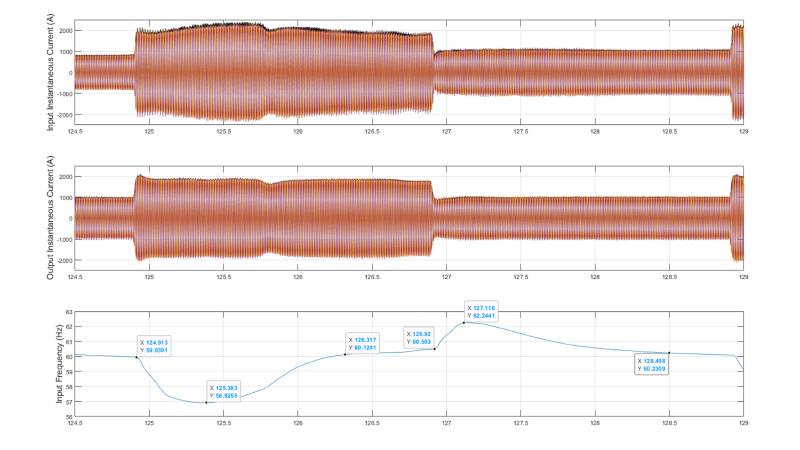
Instantaneous output voltage and current over several AI training cycles

Test outcome
The testing of Liebert ® EXL S1 demonstrated the system’s capability to provide a reliable power supply to AI power loads across multiple scenarios, including operation under generator, utility, and transition conditions. This facilitates continuous and consistent operation of accelerated computing applications.
The tests demonstrated that Liebert EXL S1 can provide consistent power to AI workloads having a unique load profile, that effectively looks like a repetitive load step followed by a load drop and maintain compliance with IEC 62040-3 Class 1 voltage performance specifications.
Vertiv large UPS systems are designed to manage AI power loads
Vertiv™ UPS solutions are designed to handle step load changes. Although these tests were carried out on Liebert EXL S1, same behavior is shared with other large power UPS, including the recently launched Vertiv™ Trinergy™ and Vertiv™ PowerUPS 9000.
In addition, Vertiv™ large UPS have unmatched overload capabilities and are designed to support also load increases well beyond the rated power. Below are the superior overload capabilities of Vertiv™ Trinergy™:
| Vertiv™ Trinergy™ | |
|---|---|
|
Overload Capabilities at 25°C |
110% continuous 125% for 10 min 150% for 1 min |
|
Overload Capabilities at 40°C |
110% for 550 sec 125% for 130 sec 150% for 25 sec |
Table 1. Vertiv™ Trinergy™ overload capabilities
All Vertiv UPS are rugged and resilient, with the ability to handle the pulsing load profile of high-performance computing applications.
Conclusion:
AI power loads are changing the pattern of the electrical demand in AI data centers from a constant pattern to a very variable pattern.
Two possible scenarios to be highlighted:
- The user wants to avoid hitting the electrical source or local generators, which aren’t sized to withstand the rate of change required by these loads.
- The user wants to avoid hitting the battery to prevent accelerating its aging due to small but frequent discharge/recharge cycles.
In the application described above, energy from the battery was only used when the large UPS source made an open transition from utility to generator.
Vertiv™ UPS systems can support both scenarios and allow power protection and quality for every case through resilient design and flexible algorithms that manage all available AC and DC sources.





